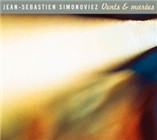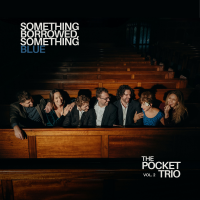Home » Jazz Articles » Album Review » Jean-Sebastien Simonoviez: Vents & Mar
Jean-Sebastien Simonoviez: Vents & Mar
Some artists never get past the belief that improvisation is a vehicle for displaying formidable chops. Speed becomes the end rather than the means, the end result being artists who fail to get truly inside the music, giving it the chance to breathe and become something more purely personal. Pianist Jean-Sebastien Simonoviez has made that leap from technical proficiency to sheer musicality. His solo debut, Vents & Marées is proof that less is often more, that interpreting material in a personal way doesn't mean losing its fundamental essence.
Vents & Marées translates to "Wind and Tide, and there's something elemental about the way Simonoviez approaches the twelve pieces, a mixture of originals, standards and a couple of obscure and intriguing choices. Simonoviez is an economical player with a delicate touch. Still, that doesn't mean he can't generate his own kind of heat, as he does on the softly dramatic "The Bedroom, one of two Bernard Hermann pieces that Simonoviez lifts from François Truffaut's 1966 film of the classic Ray Bradbury novel, Fahrenheit 451. Simonoviez colors Hermann's melancholy yet strangely romantic melody with subtle dynamics that, as understated as they are, remain deeply evocative.
Simonoviez knows not to overstay his welcome. He interprets John Coltrane's "Lonnie's Lament in a Satie-like approach of deceptive simplicity and brevity. "Naima is equally short but more abstract; yet the familiar melody never fails to find its way through Simonoviez's elegant impressionism.
The entire album has the feeling of a concert recital, one that makes demands on the listener despite being eminently attractive and gentle on the ears. There are times when Simonoviez forces the listener to lean forward and move towards the music, rather than laying back and having it wash over.
Simonoviez's own writing mirrors his interpretive approach. "Lumieres may mean "lights in a visual sense, but it's equally about weight. Simonoviez's touch is so feather-light that there are times where it seems he's breathing on the keys.
Refined in approach, and with an improvisational mindset that blends a jazz vernacular with an ethereal classicism, Vents & Marées is not about virtuosity. Still, Simonoviez's aesthetic sense makes Vents & Marées an album of rare beauty that couldn't succeed if Simonoviez were anything less than highly capable.
Track Listing
Lumieres; I Wish I Knew; The Bedroom (Fahrenheit 451); Tacha; My Favorite Things; See; Winds & Tides; If I Should Lose You; Naima; The Road (Fahrenheit 451); Lonnie's Lament; Paix.
Personnel
Jean-Sebastien Simonoviez: piano.
Album information
Title: Vents & Mar | Year Released: 2005 | Record Label: La Buissonne
Tags
PREVIOUS / NEXT
Support All About Jazz
 All About Jazz has been a pillar of jazz since 1995, championing it as an art form and, more importantly, supporting the musicians who make it. Our enduring commitment has made "AAJ" one of the most culturally important websites of its kind, read by hundreds of thousands of fans, musicians and industry figures every month.
All About Jazz has been a pillar of jazz since 1995, championing it as an art form and, more importantly, supporting the musicians who make it. Our enduring commitment has made "AAJ" one of the most culturally important websites of its kind, read by hundreds of thousands of fans, musicians and industry figures every month.





















